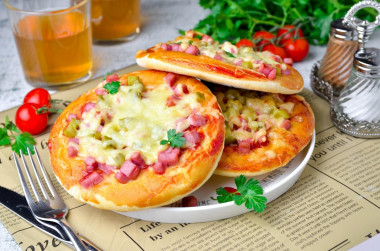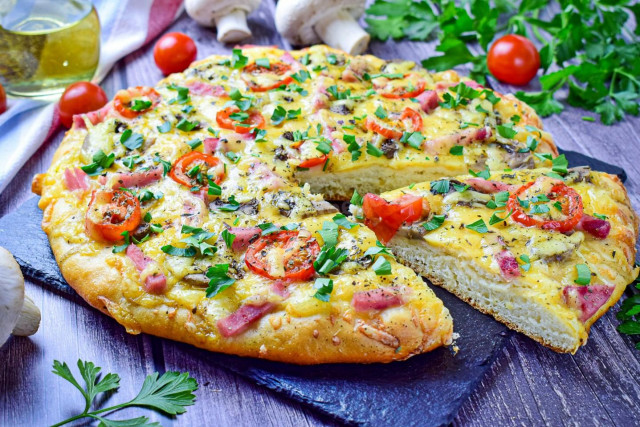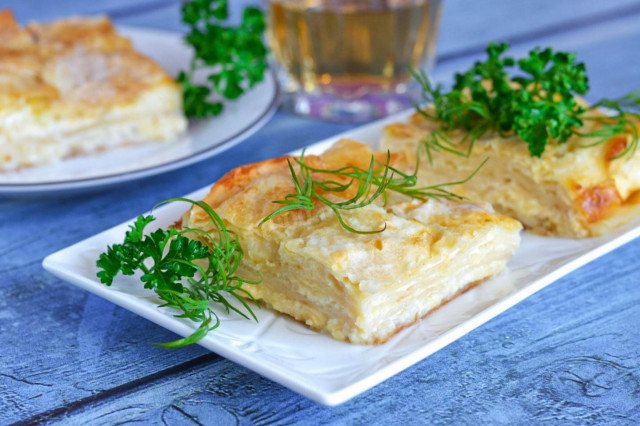Composition / ingredients
Step-by-step cooking
Step 1:
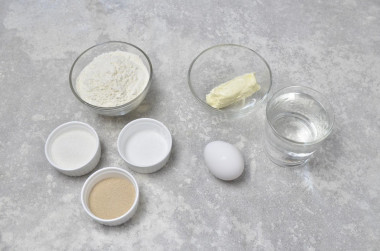
How to make a school pizza? Prepare the products. First for the test. Take natural butter, without the addition of vegetable fats. Take it out of the refrigerator in advance so that it becomes soft. Also take out the egg so that it warms up. Instead of dry yeast, you can take fresh ones, they will need three times more, 19 grams.
Step 2:

Take a large bowl in which you will knead the dough. Heat the water to a temperature of 37-38 degrees (it will be pleasantly warm to the touch, but not hot). Pour it into a bowl. Pour sugar and yeast into the water. Stir and leave to stand for 10 minutes.
Step 3:

During this time, the yeast should be activated and rise to the surface with a foam cap. If this did not happen, then take other yeast, these are not suitable.
Step 4:
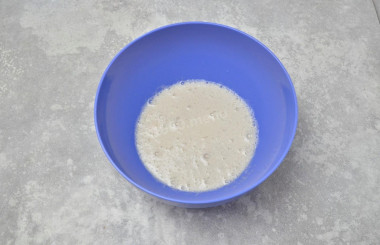
Add salt to the yeast, beat in the egg, mix well. Be sure to wash the eggs before use, as even the seemingly clean shell may contain harmful bacteria. It is best to use food detergents and a brush.
Step 5:
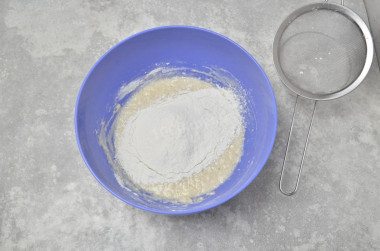
Start pouring the flour into the bowl in portions, sifting it. It is important to sift the flour to saturate it with oxygen. Then the baking will turn out to be airy and will rise well when baking. Stir the dough after each addition. First with a fork, and then with your hands.
Step 6:
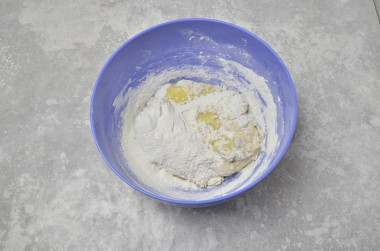
When it is already possible to knead the dough with your hands, add soft butter to it. I didn't have time to take it out in advance, so I had to melt it. Continue to knead the dough, adding flour if necessary. Be prepared for the fact that flour may need more or less than specified in the recipe. Look at the consistency, the dough should become thick enough, but not too steep.
Step 7:

When the dough starts to lag behind the walls and becomes homogeneous, stop kneading. I didn't have all the flour left, about 50 grams remained. Cover the bowl with the dough with a film or towel and put it in a warm place for proofing for 3 hours. I always put the bowl in the oven (not working!).
Step 8:
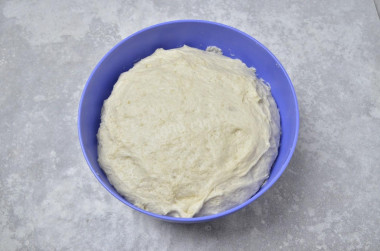
Take out the bowl every hour and knead the dough. It will increase well in size.
Step 9:

After three hours, remember it for the last time and start working.
Step 10:
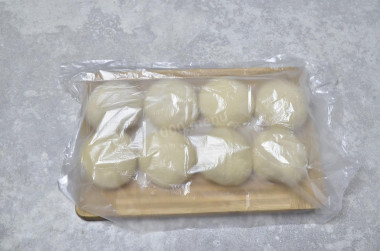
Separate pieces weighing about 80 grams from the dough. Form balls of them. I got 8 pieces and a very small piece. Cover the blanks with a film and leave to stand for 15 minutes.
Step 11:
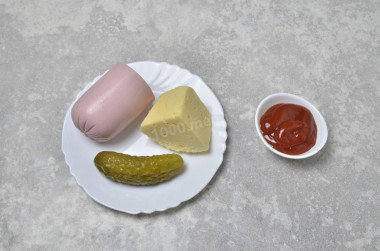
And during this time, prepare the filling. Prepare the products for her and for the sauce. I took boiled sausage, pickled cucumber and cheese. You can add something of your own, according to taste and availability. For the sauce, take the tomato paste and stir it with the same amount of water. Instead of pasta, you can take any ketchup or tomato sauce, and that's what I did.
Step 12:
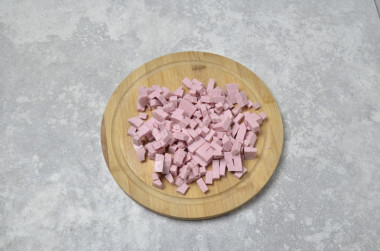
Cut the sausage into small cubes or strips.
Step 13:

Cut the cucumbers in the same way.
Step 14:
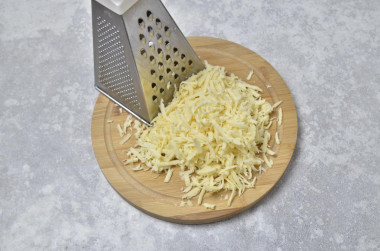
Grate the cheese on a coarse grater. Any cheese for this dish is suitable — hard, semi-hard, soft, like mozzarella. The main thing is that it is tasty, high-quality, without milk fat substitutes and melts well.
Step 15:
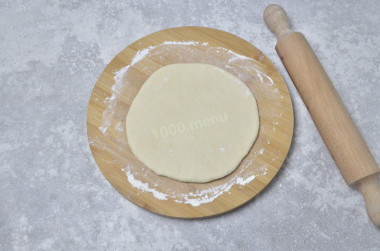
Roll out the balls that have come up into thin round cakes with a diameter of about 15 cm .
Step 16:
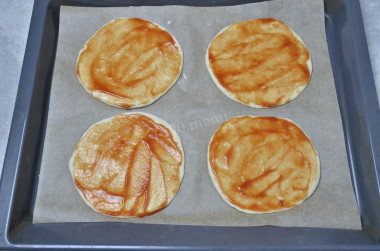
Put the blanks on a baking sheet covered with parchment. I could fit 4 pieces. Brush them with tomato sauce.
Step 17:
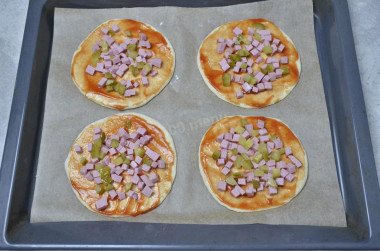
Put the sliced sausage and cucumber on top.
Step 18:
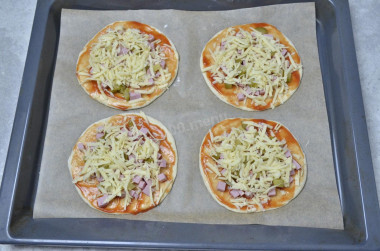
Sprinkle everything with grated cheese.
Step 19:

Preheat the oven to a temperature of 200 ° C, if it is electric, then select the top-bottom mode. Bake the pizza for 15-20 minutes until the cheese browns and melts. The exact time will depend on the characteristics of your oven. While the first batch is baking, prepare the second one and bake it after the first one.
Step 20:

Serve ready-made pizza immediately to the table, it is good with the heat from the heat. But the cooled pizza can also be reheated in the microwave. Enjoy your meal!
The liquid in which yeast is bred should be pleasant to the touch, no higher than 40 degrees. Why is this important? In a warm environment, yeast is well activated, in a hot one it will die, and in a cold one it simply will not work. To avoid unpleasant surprises, check the yeast before mixing with the rest of the ingredients. Pour a little warm milk into a bowl, stir in the yeast. Cover the bowl with a kitchen towel and put it in a warm place without drafts for 10-15 minutes. During this time, a foam yeast cap should appear on the surface of the sponge. If this did not happen, then the fermentation process has not started (the yeast is overdue or spoiled). In this case, it is worth taking other yeast, otherwise baking will not work.
Be prepared for the fact that you may need more or less flour than indicated in the recipe. Focus not on the amount of flour, but on the desired consistency of the dough. To avoid mistakes, read about flour and its properties!
Keep in mind that everyone's ovens are different. The temperature and cooking time may differ from those specified in the recipe. To make any baked dish successful, use useful information about the features of ovens !
Caloric content of the products possible in the composition of the dish
- Chicken egg - 157 kcal/100g
- Egg white - 45 kcal/100g
- Egg powder - 542 kcal/100g
- Egg yolk - 352 kcal/100g
- Ostrich egg - 118 kcal/100g
- Dutch cheese - 352 kcal/100g
- Swiss cheese - 335 kcal/100g
- Russian cheese - 366 kcal/100g
- Kostroma cheese - 345 kcal/100g
- Yaroslavsky cheese - 361 kcal/100g
- Altai cheese 50% fat content - 356 kcal/100g
- Soviet cheese - 400 kcal/100g
- Cheese "steppe" - 362 kcal/100g
- Uglich cheese - 347 kcal/100g
- Poshekhonsky cheese - 350 kcal/100g
- Lambert cheese - 377 kcal/100g
- Appnzeller cheese with 50% fat content - 400 kcal/100g
- Chester cheese with 50% fat content - 363 kcal/100g
- Edamer cheese with 40% fat content - 340 kcal/100g
- Cheese with mushrooms of 50% fat content - 395 kcal/100g
- Emmental cheese with 45% fat content - 420 kcal/100g
- Gouda cheese with 45% fat content - 356 kcal/100g
- Aiadeus cheese - 364 kcal/100g
- Dom blanc cheese (semi-hard) - 360 kcal/100g
- Lo spalmino cheese - 61 kcal/100g
- Cheese "etorki" (sheep, hard) - 401 kcal/100g
- White cheese - 100 kcal/100g
- Fat yellow cheese - 260 kcal/100g
- Altai cheese - 355 kcal/100g
- Kaunas cheese - 355 kcal/100g
- Latvian cheese - 316 kcal/100g
- Limburger cheese - 327 kcal/100g
- Lithuanian cheese - 250 kcal/100g
- Lake cheese - 350 kcal/100g
- Gruyere cheese - 396 kcal/100g
- Whole durum wheat flour fortified - 333 kcal/100g
- Whole durum wheat flour, universal - 364 kcal/100g
- Flour krupchatka - 348 kcal/100g
- Flour - 325 kcal/100g
- Granulated sugar - 398 kcal/100g
- Sugar - 398 kcal/100g
- Butter 82% - 734 kcal/100g
- Amateur unsalted butter - 709 kcal/100g
- Unsalted peasant butter - 661 kcal/100g
- Peasant salted butter - 652 kcal/100g
- Melted butter - 869 kcal/100g
- Tomato paste - 28 kcal/100g
- Salt - 0 kcal/100g
- Sausage "amateur" - 291 kcal/100g
- Sausage "Ukrainian" - 404 kcal/100g
- Diabetic sausage - 254 kcal/100g
- Sausage "doctor" - 197 kcal/100g
- Diet sausage - 170 kcal/100g
- Dairy sausage - 252 kcal/100g
- Water - 0 kcal/100g
- Pickled cucumbers - 16 kcal/100g
- Dry yeast - 410 kcal/100g





